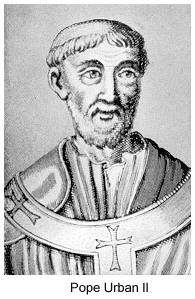 Odo of the
knightly family of Lagery was born around 1042 at Chatillon-sur Marne in
Champagne. His parents were pious and Odo followed their example. After studies
at Rheims under St. Bruno, the founder of the great Carthusian order, Odo became
a canon and archdeacon of Rheims. But he left rank and honor to be a monk at
Cluny. There under the great abbot St. Hugh he progressed mightily in the
spiritual life and was made prior. When St. Gregory VII asked Hugh for some
monks who would make good bishops, Hugh sent Odo to Rome. Made cardinal-bishop
of Ostia in 1078, Odo served Gregory with loyalty and skill in the fight against
Henry IV, Antipope Guibert, and church abuses. As legate in Germany from 1082 to
1085, Odo did accomplish much for reform by securing the election of worthy
bishops.
Odo of the
knightly family of Lagery was born around 1042 at Chatillon-sur Marne in
Champagne. His parents were pious and Odo followed their example. After studies
at Rheims under St. Bruno, the founder of the great Carthusian order, Odo became
a canon and archdeacon of Rheims. But he left rank and honor to be a monk at
Cluny. There under the great abbot St. Hugh he progressed mightily in the
spiritual life and was made prior. When St. Gregory VII asked Hugh for some
monks who would make good bishops, Hugh sent Odo to Rome. Made cardinal-bishop
of Ostia in 1078, Odo served Gregory with loyalty and skill in the fight against
Henry IV, Antipope Guibert, and church abuses. As legate in Germany from 1082 to
1085, Odo did accomplish much for reform by securing the election of worthy
bishops.
He held a synod in Saxony which passed reform decrees and condemned Antipope
Guibert. After the short pontificate of Victor III, Odo was elected pope by
acclamation on March 12, 1088. He took the name Urban II. Urban never knew
lasting peace in the bitter fight with Henry IV. He was in and out of Rome a
number of times, and at his death the struggle was far from ended. But more
important than the monotonous ups and downs in the struggle for reform was the
great event which did so much to change the Middle Ages--the crusade. The East
had been swamped by a horde of Seljuk Turks who had swarmed out of Central Asia
to threaten the Eastern Empire and make life miserable for Christian pilgrims to
the Holy Land. The great St. Gregory VII had planned to organize a crusade in
answer to anguished appeals from the shaky Eastern Empire, but the fight over
lay investiture had prevented him from doing this. Now Urban II decided to do
something about it. Most eager to end the unfortunate Eastern Schism, Urban was
anxious to oblige the Emperor. Indeed he absolved Alexius from excommunication.
Besides recovering the Holy Sepulcher of Christ, Urban hoped that the expedition
would lead to reunion of the Eastern Church with Rome and that given a nobler
ideal to fight for, the warriors of the West would rise above petty squabbles.
Accordingly, in November 1095 Urban assembled at Clermont in France 13
archbishops, 225 bishops, and 90 abbots. After the council passed reform
decrees, Urban addressed the assembly in words which set the West ablaze with
ardor. "God wills it!" was the enthusiastic reply, and from the great feudal
principalities came hard-fighting knights led by Godfrey of Lorraine, Robert of
Nomandy, Hugh of Vermandois, Raymond of Toulouse, and Bohemond of Norman Italy.
To control these strong personalities, Urban appointed Adhemar, bishop of Le Puy,
as his legate. Urban worked hard to make the crusade a success. And before his
death Jerusalem had fallen to the Christian army; but before he could hear the
good news, Urban II died on July 27, 1099. From the time of his death Urban was
honored for his sanctity, but it was only in 1881 that he was officially
beatified by Leo XIII.
Excerpted from "Popes
Through the Ages" by Joseph Brusher, S.J.

